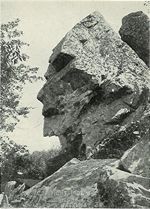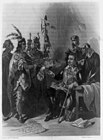Massasoit
Massasoit | |
|---|---|
| Ousamequin | |
Cyrus E. Dallin | |
| Wampanoag leader | |
| Succeeded by | Wamsutta |
| Personal details | |
| Born | Ousamequin c. 1581 |
| Died | 1661 (aged 80) |
| Children | Wamsutta, Metacomet |

Massasoit Sachem (/ˌmæsəˈsɔɪ(ɪ)t/)[1][2] or Ousamequin (c. 1581 – 1661)[3] was the sachem or leader of the Wampanoag confederacy. Massasoit means Great Sachem. Massasoit was not his name but a title. English colonists mistook Massasoit as his name and it stuck.[4]
Massasoit's people had been seriously weakened by a series of epidemics and were vulnerable to attacks by the Narragansetts, and he formed an alliance with the colonists at Plymouth Colony for defense against them. It was through his assistance that the Plymouth Colony avoided starvation during the early years.
English at Plymouth
At the time of the pilgrims' arrival in Plymouth, the realm of the Wampanoag, also known as the
Outbreaks of an unidentified disease had devastated the Pokanokets, and Massasoit sought an alliance with the colonies of New England against the neighboring Narragansetts who controlled an area west of Narragansett Bay in Rhode Island. Samoset was a minor Abenaki sachem (sagamore) who hailed from the Muscongus Bay area of Maine,[7] and he learned to speak English from fishermen who plied those waters. Massasoit sent him to approach the colonists to find out whether their intentions were peaceful.
Massasoit forged critical political and personal ties with colonial leaders
Lasting alliance

Some tension continued between Massasoit and the colonists when they refused to give up
The alliance came under other tension in later years, as the colonists expanded into new lands in order to support their growing colony. Massasoit sold a tract of land 14 miles square to Myles Standish and others of Duxbury in 1649 to alleviate tension and maintain the peace. The sale took place atop Sachem Rock, an outcropping on the Satucket River in East Bridgewater, Massachusetts. The site is listed on the National Register of Historic Places.
Children
Massasoit had five children: son Wamsutta, who was born between 1621 and 1625; son Pometecomet, Metacomet, or Metacom; son Sonkanuchoo; and daughters Amie and Sarah. Soon after his death, Wamsutta and Metacomet went to Plymouth and asked the Pilgrims to give them English names. The court named them Alexander and Philip. Wamsutta, the eldest, became sachem of the Pokanokets on the death of his father.[11] He died within a year, and his brother Metacom succeeded him in 1662.[12] Amie married Tispaquin and was the only one of Massasoit's five children to survive King Philip's War in 1676.
Legacy
This section needs additional citations for verification. (March 2011) |
The half century of peace that Massasoit so assiduously maintained collapsed soon after his death. Wamsutta broke away from his father's diplomacy and began an alliance with Connecticut Colony.
Massasoit was humane and honest, kept his word, and endeavored to imbue his people with a love of peace. He kept the Pilgrims advised of any warlike designs toward them by other tribes.[11] It is unclear when Massasoit died. Some accounts claim that it was as early as 1660; others contend that he died as late as 1662. He was anywhere from 80 to 90 at the time.[11]
Wamsutta died suddenly within a year of his succession, and Massasoit's second son Metacom became sachem of the Pokanokets and chief sachem of the Greater Wampanoag Confederacy. He believed that Wamsutta had been murdered at the hands of the Colonists, and this was one of the factors that led to King Philip's War, one of the bloodiest wars in Colonial American history.
A
Gallery
-
Meeting of Governor Carver and Massasoit
-
The Palace of Massasoit
-
Massasoit and his Warriors
See also
References
- ^ "Massasoit". Merriam-Webster.com Dictionary. Retrieved February 24, 2021.
- ^ "Massasoit Commercial - 30 Seconds". Massasoit Community College. February 25, 2020. Retrieved February 25, 2021.
- ^ "Native People" (page), "Massasoit (Ousamequin) Sachem" (section),MayflowerFamilies.com, web page:MFcom-Native Archived November 4, 2006, at the Wayback Machine
- ^ Bicknell, p. 12
- OCLC 1018149266. Retrieved 11 June 2018.
- doi:10.2307/365654. JSTOR 365654.
- ^ Bradford, William (1952). Morison, Samuel Eliot (ed.). Of Plymouth Plantation, 1620–1647. New York: Alfred A. Knopf. p. 80, n.8
- ^ a b "Pokanoket Leaders", Wampanoag Nation
- ^ Alvin G. Weeks, Massasoit of the Wampanoags, 1919.
- ^ Winslow, ch. 4
- ^ a b c Wilson, J. G.; Fiske, J., eds. (1900). . Appletons' Cyclopædia of American Biography. New York: D. Appleton.
- ^ Peirce, Ebenezer. Indian History, Zeviah Gould Mitchell, North Abington, Massachusetts, 1878
- ^ "Roger Williams National Memorial", National Park Service
- ^ "Massasoit State Park", Commonwealth of Massachusetts
Sources
- "Native People" (page), "Massasoit (Ousamequin) Sachem" (section), MayflowerFamilies.com, webpage: MFcom-Native.
- Bicknell, Thomas Williams (1908). Sowams, with Ancient Records of Sowams and Parts Adjacent. New Haven: Associated Publishers of American Records.
- Winslow, Edward (1624). Good Newes from New England. London.
- Nathaniel Philbrick, Mayflower: A Story of Courage, Community, and War, New York 2006.
Further reading
- Lisa Blee and Jean M. O'Brien, Monumental Mobility: The Memory Work of Massasoit. Chapel Hill, NC: University of North Carolina Press, 2019.
- Virginia Baker, Massasoit's Town, Sowams in Pokanoket, Its History Legends and Traditions, Published by the author, Warren, Rhode Island, 1904
External links
 Media related to Massasoit at Wikimedia Commons
Media related to Massasoit at Wikimedia Commons- . . 1914.
- . The American Cyclopædia. 1879.



